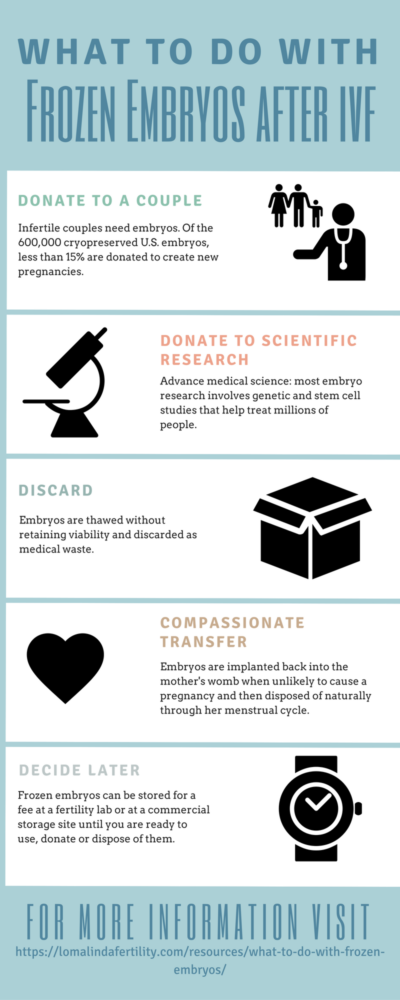After IVF: What to Do with Frozen Embryos
 Following a fresh cycle of in vitro fertilization (IVF), spare embryos (those good quality embryos that are not transferred) may be frozen and stored in a fertility lab or commercial storage site. Prior to embryo freezing, the patient or couple will need to discuss the options for the future disposition of the embryos with the physician and decide what to do with frozen embryos they may not want or be able to use in the future.
Following a fresh cycle of in vitro fertilization (IVF), spare embryos (those good quality embryos that are not transferred) may be frozen and stored in a fertility lab or commercial storage site. Prior to embryo freezing, the patient or couple will need to discuss the options for the future disposition of the embryos with the physician and decide what to do with frozen embryos they may not want or be able to use in the future.
There are numerous options and considerations, and every couple’s or individual’s decision will vary according to personal beliefs and financial considerations. The following are the primary ways to resolve what to do with unused embryos.
Embryo donation
Embryo donation is a way to donate fertilized embryos to couples who are unable to produce viable embryos on their own (those who need both an egg and sperm donation). There are an estimated 600,000 frozen embryos in storage in the United States, but less than 15 percent of those embryos are donated to another couple.
If embryo donation is chosen, the patient will have to accept that she and her partner may never know of other possible children biologically related to theirs. Some people may have a hard time with this idea, and no couple’s feelings on the topic are exactly the same. Speaking to a fertility doctor and a psychologist who specializes in fertility issues may help people decide if this option is right for them.
Donate embryos to scientific research
Donating embryos to scientific research is an option that puts the otherwise unused embryos to good use and contributes to scientific study. Embryos donated for medical research are not transferred into a patient. Most medical research of embryos involves genetic studies and occasionally the studying of stem cells within the embryos. Many fertility clinics partner with facilities that use embryos to study various medical and research issues.
Thaw and dispose of embryos
In this disposition choice, the fertility lab removes embryos from the liquid nitrogen and allows the embryos to come to room temperature without a period of culture or any attempt to retain viability. The embryos are then discarded as medical waste. For some couples, this may or may not pose a moral dilemma depending on their beliefs regarding the moral status of the embryo at this early stage in development. A psychologist may be able to help couples decide if this option is right in their case.
Compassionate transfer
Some couples don’t believe any of the above options would provide them with enough psychological closure for dealing with their spare embryos. In these instances, a compassionate transfer may be performed.
During a compassionate transfer, the embryos are implanted back into the uterus of the woman who created the embryo in an IVF procedure at a time in the woman’s cycle when it’s the least likely to cause a pregnancy. The embryo is then disposed naturally through the woman’s next menstrual cycle. This is an expensive choice because the services rendered will be charged at the normal rate.
Not all fertility specialists will perform a compassionate transfer, so if this is something a patient wants done it’s important to discuss this option with the fertility specialist prior to treatment.
Do nothing, decide later
Frozen embryos can be stored for a yearly fee at some fertility labs. Other labs require the patient to relocate their embryos to a commercial storage site until they are ready to use the embryos or dispose of them. Patients who chose this option will need to revisit the decision of what to do at least once every five years.
No matter what disposal method patients choose, an open line of communication with their partner and fertility specialist will guide them to the best choice.
